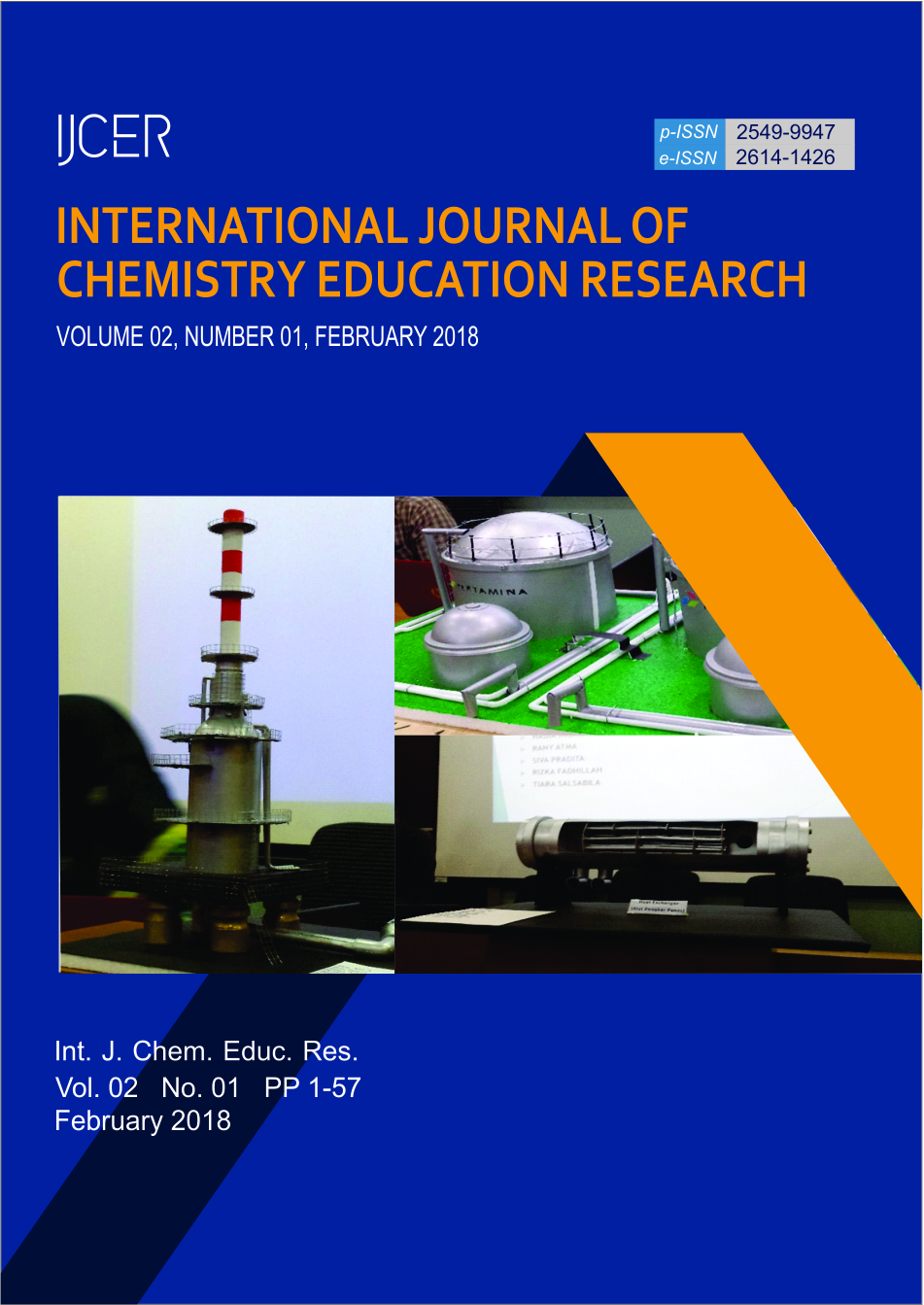Main Article Content
Abstract
ABSTRACT: This research aims to develop MEc Bond learning media (Magnetic Educhem Bonding) for students with hearing impairment in (Islamic) senior high school based on chemo-entrepreneurship modeling. This research uses the development model by Borg & Gall that includes the identification of potentials and problems, product selection, literature review, planning, developing initial product draft, initial field trials and product revisions, and it ends with major field trials and product revision. The subjects of this research include material experts, media experts, disability experts, senior high school chemistry teachers and students. The data of this research are taken by using several instruments:
interview guide, product quality assessment sheet, and student response sheet. The interview result is analyzed by using descriptive technique, assessment result of product quality is analyzed by using categorical descriptive quantitative technique, and student's response is analyzed by using percentage technique. The results of this research has been developed with the input from the validation specialist and chemistry teachers. Learning media which is developed has best quality, according to the assessment of chemistry teachers in (Islamic) senior high school, with the ideality percentage of 91.02%. In general, students with hearing impairment might respond positively which gets the ideality percentage of 86% to the MEc Bond learning media which makes the material chemical bonds easier to be understood and fun. In addition, the media is desperately necessary for studying chemical bonding in class and it can foster entrepreneurial spirit for the students in the form of making learning media of
chemical bonds.
Keywords: chemo-entrepreneurship, learning media, chemical bonds, MEc bond
Received: 16 January 2018, Revised: 31 January 2018, Accepted: 25 February 2018
Article Details
Author retain copyright and grant the journal right of first publication with the simultaneously licenced under A Creative Commons Attribution (CC-By-SA) 4.0 License that allows others to share the work with an acknowledgment of the worsk's authorship and initial publication in this journal.
References
- S. Winarsih, H. Jamal, A. Asiah, F. H. Idris, E. Adnan, B. Prasojo, I. Tan, A. A. Masyhuri, Syafrizal, S. Majid, N. Hasnul, A. Riyanto, L. Bunawan, C. Rukiyah and I. K. Sembada, Panduan Penanganan
- Anak Berkebutuhan Khusus bagi Pendamping (Orang Tua, Keluarga, dan Masyarakat (Kementerian Pemberdayaan dan Perlindungan Anak, Jakarta, 2013).
- D. F. Kuratko, Entrepreneurship Theory and Practice, 29, 5, 577-598 (2005).
- A. T. Hananta, Jurnal Pendidikan Guru Sekolah Dasar,16, 4, 3-11 (2015).
- L. Dewi, A. Yani and A. D. Suhardini, Mimbar, 31 , 2, 399-408 (2015).
- H. K. Wu, J.S. Krajcik and E. Soloway, J. Res. Sci. Teach, 38, 7, 821 -842 (2001).
- Sudijono, Pengantar Statistika Pendidikan (CV Rajawali, Jakarta, 2009).
- Muzaphire and I. Ramadhani, Jurnal Inklusi, 2, 2, 243-258 (2015).
- R. W. Borg and M.D. Gall, Educational Research; An Introduction, Fifth Edition (Longman, New York:1989).
- Z. Arifin, Penelitian Pendidikan: Metode dan Paradigma Baru (PT. Remaja Rosdakarya, Bandung, 2012).
- S. E. P. Widoyoko, Evaluasi Program Pembelajaran (Pustaka Pelajar, Yogyakarta, 2012).
References
S. Winarsih, H. Jamal, A. Asiah, F. H. Idris, E. Adnan, B. Prasojo, I. Tan, A. A. Masyhuri, Syafrizal, S. Majid, N. Hasnul, A. Riyanto, L. Bunawan, C. Rukiyah and I. K. Sembada, Panduan Penanganan
Anak Berkebutuhan Khusus bagi Pendamping (Orang Tua, Keluarga, dan Masyarakat (Kementerian Pemberdayaan dan Perlindungan Anak, Jakarta, 2013).
D. F. Kuratko, Entrepreneurship Theory and Practice, 29, 5, 577-598 (2005).
A. T. Hananta, Jurnal Pendidikan Guru Sekolah Dasar,16, 4, 3-11 (2015).
L. Dewi, A. Yani and A. D. Suhardini, Mimbar, 31 , 2, 399-408 (2015).
H. K. Wu, J.S. Krajcik and E. Soloway, J. Res. Sci. Teach, 38, 7, 821 -842 (2001).
Sudijono, Pengantar Statistika Pendidikan (CV Rajawali, Jakarta, 2009).
Muzaphire and I. Ramadhani, Jurnal Inklusi, 2, 2, 243-258 (2015).
R. W. Borg and M.D. Gall, Educational Research; An Introduction, Fifth Edition (Longman, New York:1989).
Z. Arifin, Penelitian Pendidikan: Metode dan Paradigma Baru (PT. Remaja Rosdakarya, Bandung, 2012).
S. E. P. Widoyoko, Evaluasi Program Pembelajaran (Pustaka Pelajar, Yogyakarta, 2012).




